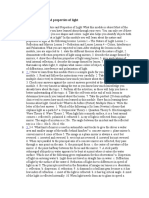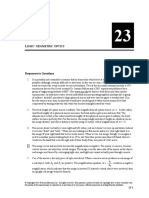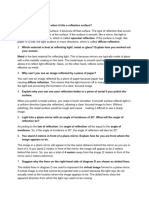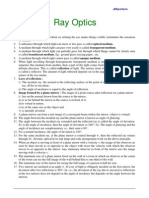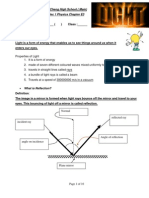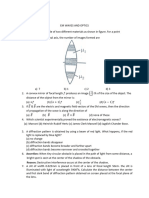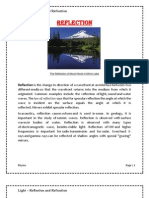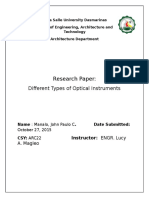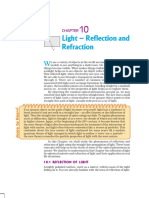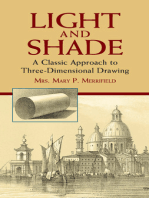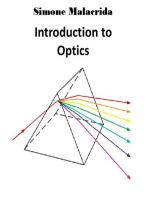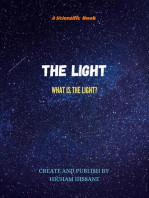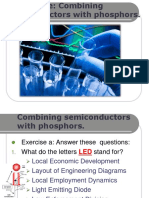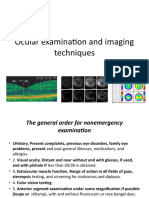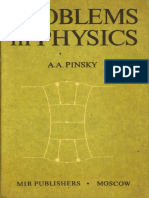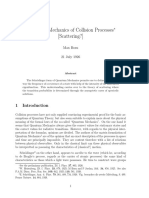Chapter 10 Review Answers
Chapter 10 Review Answers
Uploaded by
karmalkar1020Copyright:
Available Formats
Chapter 10 Review Answers
Chapter 10 Review Answers
Uploaded by
karmalkar1020Copyright
Available Formats
Share this document
Did you find this document useful?
Is this content inappropriate?
Copyright:
Available Formats
Chapter 10 Review Answers
Chapter 10 Review Answers
Uploaded by
karmalkar1020Copyright:
Available Formats
Chapter Review Answers (Student textbook pages 444 and 445)
Make Your Own Summary
Reviewing Key Terms
1. Incandescent, fluorescent
2. Bioluminescence
3. Reflection
4. incidence, reflection
5. virtual
6. concave
7. focal, principal axis
8. convex
Knowledge and Understanding
9. An atom absorbs energy and becomes excited. When the atom releases its energy, it is oft en in the form
of light.
10. Electrical energy creates a separation of charge. Energetic electrons are emitted from an electrode. Th e
electron collides with an atom in the gas thus exciting it. The excited atom releases its excess energy as
light.
11. Visible light is composed of different wavelengths, and the individual wavelengths are associated with a
particular colour.
12. A light ray is an imaginary arrow that points in the direction in which the light is travelling.
13. Light rays are reflecting off the mirror in a way that makes them to appear to be coming from behind the
mirror. This is called a virtual image.
14. Draw rays parallel to the principal axis then reflecting off the mirror. Extend the reflecting rays back behind
the mirror. The point where the lines meet is the focal point.
15. There is no true focal point because parallel rays that reflect from the mirror do not all cross the principal
axis at the same point. The mirror, therefore, cannot produce an image that is focussed properly.
16. The centre of a convex mirror protrudes outward from the edges.
Thinking and Investigation
17. No. The light ray will reflect to your right. The light will never reach your eye.
18. The difference is caused by the nature of the surface of the water. If it is perfectly still, it will reflect like a
plane mirror. If there is any wind or boats disturbing the surface of the water, it will be rough and will no
longer act like a plane mirror.
19. Concave: You can collect a lot of sunlight and focus it on one small area. This “concentrated” sunlight is
hot enough to ignite paper or dry grass.
20. 3 m
Communication
21. Example: solar cookers, and stealth aircraft
22. Example: security mirrors
23. Fusion reactions, in which atoms combine, or fuse, occur inside the Sun and release large amounts of
energy. The energy is transferred to the surface of the Sun where it excites atoms on the surface. When
these atoms release some excess energy, it is in the form of light.
24. (a)
(b) The blue ray goes from the top of the object to mirror and is reflected back through F and beyond. The
green ray goes from the top of the object through F until it hits the mirror and is reflected back, parallel to
the principal axis. The red ray goes from the top of the object through C, which is twice the distance from
the mirror as F.
(c) The real image is inverted. di = 13.33 cm (in front ofmirror); hi = −3.33 cm (inverted)
25. If you have to extend reflected rays backward, the image is virtual. If rays actually meet, the image is real.
Application
26. The object is placed at the centre of curvature, 3.2 m from the mirror.
27. The concrete structures reflect sound waves. A lookout person, standing at the focal point of the concave
“sound mirror” could hear an airplane long before it came into sight.
28. Example: light technician for the Famous People Players, an artist, and a toy designer.
29. (a) GaN LED lighting is predicted to be three times more efficient than fluorescent lighting.
(b) They could last 100 000 hours.
(c) Example: LEDs do not contain mercury, are a fraction of the cost, last longer, do not flicker, and reach
maximum brightness as soon as they are switched on.
(d) Not currently, although it is possible.
(e) Example: Overall reduced energy consumption and waste (i.e., fewer bulbs) and eliminate headaches
and other side effects since they don’t flicker.
You might also like
- Physics Lesson Note SS2 3rd Term, 2023 - 1Document56 pagesPhysics Lesson Note SS2 3rd Term, 2023 - 1aloooab9No ratings yet
- Iso 13320 2020Document15 pagesIso 13320 2020Edu CorrêaNo ratings yet
- O-LEVEL PHYSICS Light WORKDocument41 pagesO-LEVEL PHYSICS Light WORKojilong100% (1)
- 1st Week: Department: - Meas. Inst. Nos.: Location: MonthDocument8 pages1st Week: Department: - Meas. Inst. Nos.: Location: MonthSuresh Kumar RanaNo ratings yet
- class -10 physicsDocument7 pagesclass -10 physicsAnand GuptaNo ratings yet
- Module 3 The Nature and Properties of LightDocument12 pagesModule 3 The Nature and Properties of LightsivaNo ratings yet
- Module 3 The Nature and Properties of LightDocument31 pagesModule 3 The Nature and Properties of LightAsif Muhammad100% (6)
- Module 3 Physics 2Document31 pagesModule 3 Physics 2akexiamarielleaquinoNo ratings yet
- Chapter-12 Geometrical OpticsDocument8 pagesChapter-12 Geometrical OpticsKashif FazalNo ratings yet
- physics diagramsDocument12 pagesphysics diagramsalishasequeira9No ratings yet
- Ch23 Giancoli7e ManualDocument32 pagesCh23 Giancoli7e ManualRMNo ratings yet
- The Nature and Properties of Light PDFDocument32 pagesThe Nature and Properties of Light PDFtees cNo ratings yet
- OPTICSDocument16 pagesOPTICSSoumyajeet PradhanNo ratings yet
- Print - Light WavesDocument22 pagesPrint - Light WavesantonellidejanNo ratings yet
- Answer True or False To Each StatementDocument6 pagesAnswer True or False To Each StatementQinbo ZhangNo ratings yet
- Reflection and RefractionDocument4 pagesReflection and Refractionjanathiefernando23No ratings yet
- Physics Lesson 5 ..Document13 pagesPhysics Lesson 5 ..salunkeanushka409No ratings yet
- Ray Optics PDFDocument21 pagesRay Optics PDF1996vishakNo ratings yet
- Reflection & Refraction of LightDocument60 pagesReflection & Refraction of LightgeniusamahNo ratings yet
- PH 11 OpticsDocument12 pagesPH 11 Opticsneiljain10002No ratings yet
- 5911bf8c1c55acc27d97332f6cf30ab8 (1)Document8 pages5911bf8c1c55acc27d97332f6cf30ab8 (1)rowanbandiNo ratings yet
- Reflection & Refraction of LightDocument43 pagesReflection & Refraction of Lightgbokoyiayomide17No ratings yet
- 01 Optics 1 - Reflection & Refraction of LightDocument57 pages01 Optics 1 - Reflection & Refraction of Lightpolymath thesolverNo ratings yet
- main year 8 note phyDocument23 pagesmain year 8 note phyuzorsikecNo ratings yet
- Chapter 12 Light HandoutDocument3 pagesChapter 12 Light Handoutnanika.singh19No ratings yet
- 2 Mark Questions On Light Reflection and Refraction For CBSE Class 10 Science Chapter 9Document2 pages2 Mark Questions On Light Reflection and Refraction For CBSE Class 10 Science Chapter 9SACHIN ClassNo ratings yet
- important questionsDocument5 pagesimportant questionsSayantani ChakrabortyNo ratings yet
- Optics Student NotesDocument25 pagesOptics Student Notespwysz093No ratings yet
- Physical Science: Quarter 2 - Week 5Document20 pagesPhysical Science: Quarter 2 - Week 5Cristian Steven Murillo100% (1)
- Choose The Correct Answer: Revision WorksheetDocument4 pagesChoose The Correct Answer: Revision Worksheetkeerthanayadav2011No ratings yet
- Light - X SSMJLADocument17 pagesLight - X SSMJLAbasavarajNo ratings yet
- Chung Cheng High School (Main) Sec 1 Physics Chapter E3Document16 pagesChung Cheng High School (Main) Sec 1 Physics Chapter E3Ken TanNo ratings yet
- Light-1Document34 pagesLight-1krishsingh753295No ratings yet
- Grade 10 Light and Optics NotesDocument5 pagesGrade 10 Light and Optics NotesJason FokNo ratings yet
- Ray Optics and Optical InstrumentsDocument4 pagesRay Optics and Optical InstrumentsamberanasuyanayakNo ratings yet
- chp12 NotesDocument4 pageschp12 NotesManinder ReddyNo ratings yet
- Science pt1Document5 pagesScience pt1HAZEL JEAN CAMUSNo ratings yet
- Chapter 4: Many Properties of Light Can Be Understood Using A Wave Model of LightDocument17 pagesChapter 4: Many Properties of Light Can Be Understood Using A Wave Model of Lightapi-114939020100% (1)
- 4 574735038738858386 PDFDocument7 pages4 574735038738858386 PDFAmirNo ratings yet
- Light-Reflection NotesDocument15 pagesLight-Reflection NotesSuma LathaNo ratings yet
- Techniques in MicrosDocument45 pagesTechniques in MicrosdoodoobutteredNo ratings yet
- Em Waves and Optics_230210_123402Document4 pagesEm Waves and Optics_230210_123402Talitha SimonNo ratings yet
- PhysicsDocument16 pagesPhysicsatlas0372No ratings yet
- ReflectionDocument24 pagesReflectionjainamanjainjainNo ratings yet
- Class X Physics Question Bank:: HUMAN Eye and The Colourful WorldDocument9 pagesClass X Physics Question Bank:: HUMAN Eye and The Colourful WorldSCReddyNo ratings yet
- Different Types of Optical InstrumentsDocument9 pagesDifferent Types of Optical InstrumentsCarlos Othello BaloloyNo ratings yet
- Reflection of Light Plane MirrorDocument21 pagesReflection of Light Plane MirrorAdam Fadhli Abdul RazakNo ratings yet
- PS Q4 L4-Melc-9Document10 pagesPS Q4 L4-Melc-9Lozada Darah AltheaNo ratings yet
- Light CW - Mod 1Document4 pagesLight CW - Mod 1Jayaprasanna VenkatesanNo ratings yet
- Physics ProjectDocument21 pagesPhysics ProjectAnonymous f4F3uRNo ratings yet
- Group 3 - 2Document30 pagesGroup 3 - 2Glenda AstodilloNo ratings yet
- Pointers To Review ScienceDocument2 pagesPointers To Review Sciencederapite.ceeNo ratings yet
- G 8 Light Exercise AnswersDocument8 pagesG 8 Light Exercise Answersmittal3458No ratings yet
- Igcse Light Worksheet - CompressDocument45 pagesIgcse Light Worksheet - CompressCally ChewNo ratings yet
- IGCSE Light WorksheetDocument45 pagesIGCSE Light WorksheetAref DahabrahNo ratings yet
- Physics PDFDocument27 pagesPhysics PDFSamita MariyaNo ratings yet
- Light and Shade: A Classic Approach to Three-Dimensional DrawingFrom EverandLight and Shade: A Classic Approach to Three-Dimensional DrawingRating: 4 out of 5 stars4/5 (8)
- Unit 3 Lesson 5 Combining Semiconductors Into Phosphors 2017 Teacher'sDocument34 pagesUnit 3 Lesson 5 Combining Semiconductors Into Phosphors 2017 Teacher'sThomas Cancino LastraNo ratings yet
- PHYSICAL SCIENCE QUARTER 2 MODULE 3 NDocument26 pagesPHYSICAL SCIENCE QUARTER 2 MODULE 3 NLeslie jane BaguioNo ratings yet
- S6 Physics P2Document42 pagesS6 Physics P2annetbulyaba0No ratings yet
- Anti Sleep ProjectDocument4 pagesAnti Sleep Projectmbuja mbujaNo ratings yet
- LED Street Light Spec T1B Series 40w-120wDocument10 pagesLED Street Light Spec T1B Series 40w-120wLuminhomeLightingNo ratings yet
- Ocular Examination and Imaging TechniqueDocument33 pagesOcular Examination and Imaging TechniqueluckyNo ratings yet
- Finding The Absorption Spectrum of Coleus LeavesDocument8 pagesFinding The Absorption Spectrum of Coleus LeavesMalak KamalNo ratings yet
- Electromagnetic WavesDocument14 pagesElectromagnetic WavesMay Ann SabanganNo ratings yet
- Book Soil AnalysisDocument389 pagesBook Soil AnalysisNaztovenNo ratings yet
- Problemas PDFDocument342 pagesProblemas PDFJoao Rafael100% (1)
- Fluorescent Lighting FixtureDocument17 pagesFluorescent Lighting FixtureelyNo ratings yet
- Color Light LabDocument3 pagesColor Light Labemily nNo ratings yet
- Dark FieldDocument15 pagesDark FieldalexpiusNo ratings yet
- 2nd Term BookletDocument181 pages2nd Term BookletAhmed ElabasyNo ratings yet
- Palram SolarSmart Technology Brochure (En) PDFDocument2 pagesPalram SolarSmart Technology Brochure (En) PDFLucky TraderNo ratings yet
- Cruze ST 22CZ2: Interactive Menu Product CertificationDocument6 pagesCruze ST 22CZ2: Interactive Menu Product CertificationHeriberto DiazNo ratings yet
- Motion Mountain-Volume3Document456 pagesMotion Mountain-Volume3Saleem KhanNo ratings yet
- Sociology A Down To Earth Approach Canadian 6th Edition Henslin Test Bank 1Document36 pagesSociology A Down To Earth Approach Canadian 6th Edition Henslin Test Bank 1dustinduncanpmsdwgeait100% (38)
- P Science 3 Language Worksheet AnswersDocument4 pagesP Science 3 Language Worksheet Answerstamerat100% (1)
- Conservation of Underwater Archaeological Finds ManualDocument95 pagesConservation of Underwater Archaeological Finds Manualfred2000levi100% (1)
- LedsMaster LED LightingDocument29 pagesLedsMaster LED LightingMurali KannanNo ratings yet
- RBW PoDetail Internal 01Document2 pagesRBW PoDetail Internal 01ghyd artiagaNo ratings yet
- Max Born PaperDocument22 pagesMax Born PaperChukwunonso ArinzeNo ratings yet
- Electromagnetic Waves: QUICK REVISION (Important Concepts & Formulas)Document10 pagesElectromagnetic Waves: QUICK REVISION (Important Concepts & Formulas)haleem ghaniNo ratings yet
- ColorSource PAR Datasheet RevpDocument8 pagesColorSource PAR Datasheet RevpIleana GarciaNo ratings yet
- TLE DocxreviewerDocument96 pagesTLE DocxreviewerBelElpanagNo ratings yet
- DeltaOHM HD30.1 SpectroradiometerDocument3 pagesDeltaOHM HD30.1 SpectroradiometersangkertadiNo ratings yet
- GEOCHEMICAL DRAINAGE SURVEY and GEOBOTANYDocument16 pagesGEOCHEMICAL DRAINAGE SURVEY and GEOBOTANYVavachi vavaNo ratings yet






